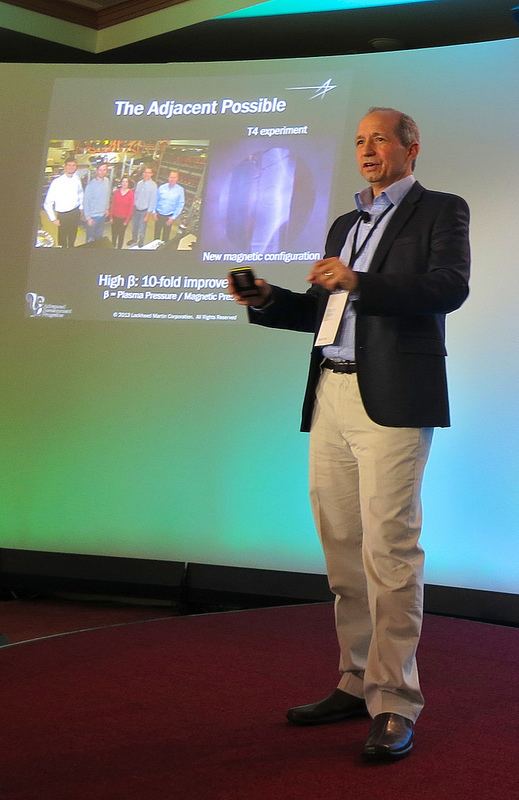 | ||
The Lockheed Martin Compact Fusion Reactor (also known as a high-beta fusion reactor, or the 4th generation prototype T4) is a project being developed by a team led by Charles Chase of Lockheed Martin’s Skunk Works. The project was first presented at the Google Solve for X forum on February 7, 2013.
Contents
The "high beta" configuration allows a compact fusion reactor design and speedier development timeline. The plan was to "build and test a compact fusion reactor in less than a year with a prototype to follow within five years." The prototype would be a 100-megawatt deuterium and tritium reactor measuring seven feet by 10 feet that could fit on the back of a large truck and be about 10 times smaller than current reactor prototypes.
High beta implies that the ratio of plasma pressure to the magnetic pressure is 1 (or even higher), compared to tokamak designs that reach only .05.
History
The Lockheed Martin project began in 2010.
In October 2014 Lockheed Martin announced that they would attempt to develop a compact fusion reactor that would fit "on the back of a truck" and produce 100 MW output - enough to power a town of 80,000 people.
The chief designer and technical team lead for the Compact Fusion Reactor (CFR) is Thomas McGuire. McGuire studied fusion as a source of space propulsion in graduate school in response to a NASA desire to improve travel times to Mars.
In May 2016 Rob Weiss announced that Lockheed Martin continued to support the project and would increase its investment in it.
Design
CFR plans to achieve high beta (the ratio of plasma pressure to the magnetic pressure) by combining cusp confinement and magnetic mirrors to confine the plasma. Cusps are sharply bent magnetic fields. Ideally, the plasma forms a sheath along the surface of the cusps and plasma leaks out along the axis and edges of the sharply bent field. The plasma lost along the edges recycles back into the cusps.
CFR uses two mirror sets. A pair of ring mirrors is placed inside the cylindrical reactor vessel at either end. The other mirror set encircles the reactor cylinder. The ring magnets produce a type of magnetic field known as a diamagnetic cusp, in which magnetic forces rapidly change direction and push the nuclei towards the midpoint between the two rings. The fields from the external magnets push the nuclei back towards the vessel ends.
Magnetic field strength is an increasing function of distance from the center. This implies that as the plasma pressure causes the plasma to expand, the magnetic field becomes stronger at the plasma edge, increasing containment.
CFR innovatively employs superconducting magnets. These allow strong magnetic fields to be created with less energy than conventional magnets. The CFR has no net current, which Lockheed claimed eliminates the prime source of plasma instabilities. The plasma has a favorable surface-to-volume ratio, which improves confinement. The plasma's small volume reduces the energy needed to achieve fusion.
The project plans to replace the microwave emitters that heat the plasma in their prototypes with neutral beam injection, in which electrically neutral deuterium atoms transfer their energy to the plasma. Once initiated, the energy from fusion maintains the necessary temperature for subsequent fusion events.
Lockheed Martin is initially targeting a relatively small device that is approximately the size of a conventional jet engine. The prototype is approximately 1 meter by 2 meters in size. The eventual device may reach 21 m in width. The company claims that this enables a much faster development cycle since each design iteration is shorter and far lower cost than large-scale projects such as the Joint European Torus or ITER.
Challenges
Ring magnets require protection from the plasma's neutron radiation. Plasma temperatures must reach many millions of Kelvin. Superconducting magnets must be kept just above absolute zero to maintain superconductivity.
The 'blanket' component that lines the reactor vessel has two functions: it captures the neutrons and transfers their energy to a coolant and forces the neutrons to collide with lithium atoms, transforming them into tritium to fuel the reactor. The blanket would be an estimated 80–150 cm thick and weigh 300–1000 tons.
T-4
Technical results presented on the T4 experiment in 2015 showed a cold, partially ionized plasma with the following parameters: peak electron temperature of 20 Electron volts, 1E16 m−3 electron density, less than 1% ionization fraction and 3 kW of input power. No confinement or fusion reaction rates were presented.
Two theoretical reactor concepts were presented by Tom McGuire in 2015. An ideal configuration weighing 200 metric tons with 1 meter of cryogenic radiation shielding and 15 Tesla Magnets. A conservative configuration weighing 2,000 metric tons, 2 meters of cryogenic radiation shielding, and 5 Tesla magnets was also presented.
Patents
Lockheed Martin applied for three patents US application 20140301518A1 ,US application 20140301519A1 and US application 20140301517A1 .
Criticism
Physics professor and director of the UK's national Fusion laboratory Steven Cowley called for more data, pointing out that the current thinking in fusion research is that "bigger is better". Other fusion reactors achieve 8 times improvement in heat confinement when machine size is doubled.
